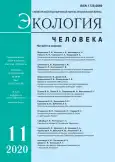The problem of statistical stability of parameters of the cardiovascular system
- Authors: Eskov V.V.1, Orlov E.V.2, Bashkatova Y.V.1, Melnikova E.G.1
-
Affiliations:
- Federal Science Center Scientific-research Institute for System Studies of the Russian Academy of Sciences
- Samara State Medical University
- Issue: Vol 27, No 11 (2020)
- Pages: 27-31
- Section: Articles
- URL: https://journals.rcsi.science/1728-0869/article/view/52799
- DOI: https://doi.org/10.33396/1728-0869-2020-11-27-31
- ID: 52799
Cite item
Full Text
Abstract
Full Text
##article.viewOnOriginalSite##About the authors
V. V. Eskov
Federal Science Center Scientific-research Institute for System Studies of the Russian Academy of Sciences
Email: firing.squad@mail.ru
кандидат медицинских наук Moscow
E. V. Orlov
Samara State Medical UniversitySamara, Russia
Yu. V. Bashkatova
Federal Science Center Scientific-research Institute for System Studies of the Russian Academy of SciencesMoscow
E. G. Melnikova
Federal Science Center Scientific-research Institute for System Studies of the Russian Academy of SciencesMoscow
References
- Филатова О. Е., Гудков А. Б., Еськов В. В., Чемпалова Л. С. Понятие однородности группы в экологии человека // Экология человека. 2020. № 2. С. 40-44. Filatova O. E., Gudkov A. B., Eskov V. V., Chempalova L. S. The Concept of Uniformity of a Group in Human Ecology. Ekologiya cheloveka [Human Ecology]. 2020, 2, pp. 40-44. [In Russian]
- Bernshtein N. A. The coordination and regulation of movements. Oxford, New York, Pergamon Press, 1967, 196 p.
- Braunlin E., Tolar J., Mackey-Bojack S., Masinde T., Krivit W., Schoen F. J. Clear cells in the atrioventricular valves of infants with severe human mucopolysaccharidosis (hurler syndrome) are activated valvular interstitial cells. Cardiovascular Pathology. 2011, 20, pp. 315-321.
- Brown R., Macefield V. G. Skin sympathetic nerve activity in humans during exposure to emotionally-charged images: sex differences. Frontiers in Physiology. 2014, 5, p. 111.
- Chan N., Choy C. Screening for atrial fibrillation in 13 122 Hong Kong citizens with smartphone electrocardiogram. Heart. 2017, 103, pp. 24-31.
- Churchland M. M., Cunningham J. P., Kaufman M. T., Foster J. D., Nuyujukian P., Ryu S. I., Shenoy K. V. Neural population dynamics during reaching. Nature. 2012, 487, pp. 51-56.
- Eskov V. M. Models of hierarchical respiratory neuron networks. Neurocomputing. 1996, 11 (2-4), pp. 203-226.
- Eskov V. M., Filatova O. E. Problem of identity of functional states in neuronal networks. Biophysics. 2003, 48 (3), pp. 497-505.
- Eskov V. M., Filatova O. E. Problem of identity of functional states of neuronal systems. Biophysics. 2003, 48 (3), pp. 526-534.
- Eskov V. M., Khadartsev A. A., Eskov V. V., Vokhmina J. V. Chaotic dynamics of cardio intervals in three age groups of indigenous and nonindigenous populations of Ugra. Advances in gerontology. 2016, 6 (3), pp. 191-197.
- Eskov V. M., Bazhenova A. E., Vochmina U. V., Filatov M. A., Ilyashenko L. K. N.A. Bernstein hypothesis in the description of chaotic dynamics of involuntary movements of person. Russian journal of biomechanics. 2017, 21 (1), pp. 14-23.
- Koska, J., Ksinantova I., Sebökova E, Kvetnansky R, Klimes I, Chrousos G, Pacak K. Endocrine regulation of subcutaneous fat metabolism during cold exposure in humans. Annals of the New York Academy of Sciences. 2002, 967, 1, pp. 500-505.
- Lovallo W. R. Psychophysiological reactivity: mechanisms and pathways to cardiovascular disease. Psychosomatic Medicine. 2003, 65 (1), pp. 36-45.
- McCraty R., Shaffer F. Heart Rate Variability: new perspectives on physiological mechanisms, assessment of self-regulatory capacity, and health risk. Global advances in health and medicine. 2015, 4 (1), pp. 46-61.
- Sussillo D., Churchland M. M., Kaufman M. T., Shenoy K. V. A neural network that finds a naturalistic solution for the production of muscle activity. Nature Neuroscience. 2015, 18, pp. 1025-1033.
- Vokhmina Y. V., Eskov V. M., Gavrilenko T. V., Filatova O. E. Measuring order parameters based on neural network technologies. Measurement techniques. 2015, 58 (4), pp. 462-466.
- Zilov V. G., Khadartsev A. A., Eskov V. V., Eskov V. M. Experimental Study of Statistical Stability of Cardiointerval Samples. Bulletin of experimental biology and medicine. 2017, 164 (2), pp. 115-117.
- Zilov V. G., Khadartsev A. A., Ilyashenko L. K., Eskov V. V., Minenko I. A. Experimental analysis of the chaotic dynamics of muscle biopotentials under various static loads. Bulletin of experimental biology and medicine. 2018, 165 (4), pp. 415-418.
- Zilov V. G., Khadartsev A. A., Eskov V. V., Ilyashenko L. K., Kitanina K. Yu. Examination of statistical instability of electroencephalograms. Bulletin of experimental biology and medicine. 2019, 168 (7), pp. 5-9.
- Zilov V. G., Khadartsev A. A., Eskov V. M., Ilyashenko L. K. New effect in physiology of human nervous muscle system. Bulletin of experimental biology and medicine. 2019, 167 (4), pp. 419-423.
Supplementary files







